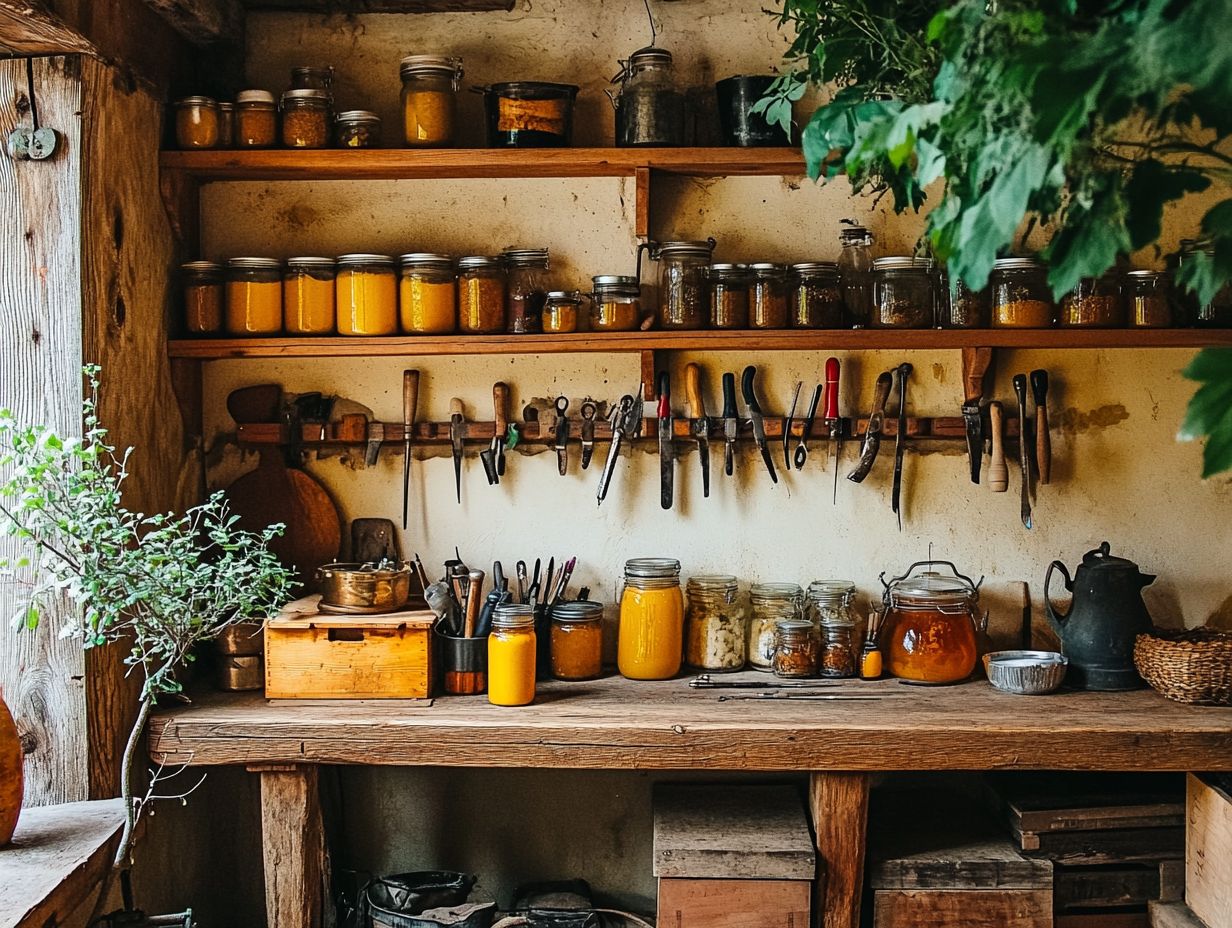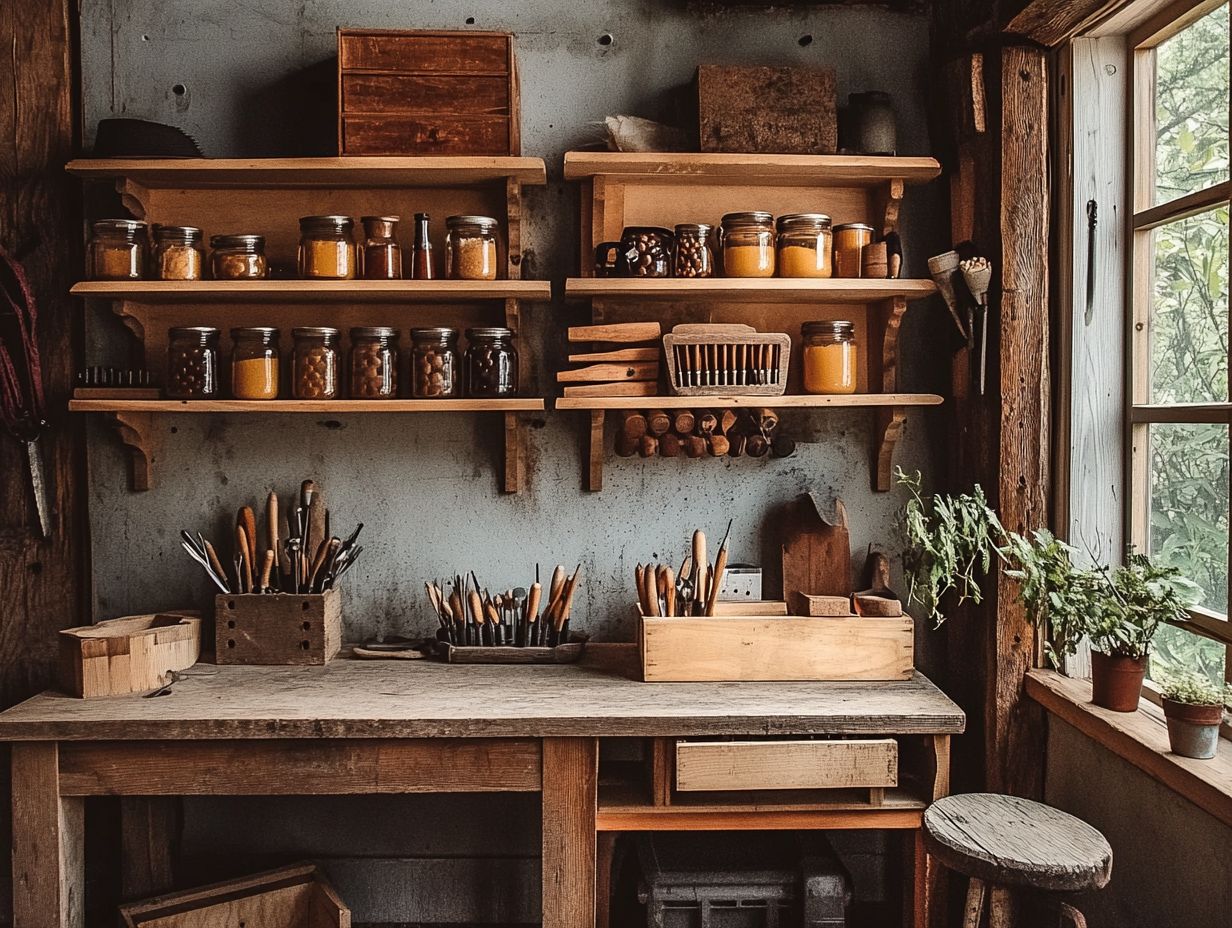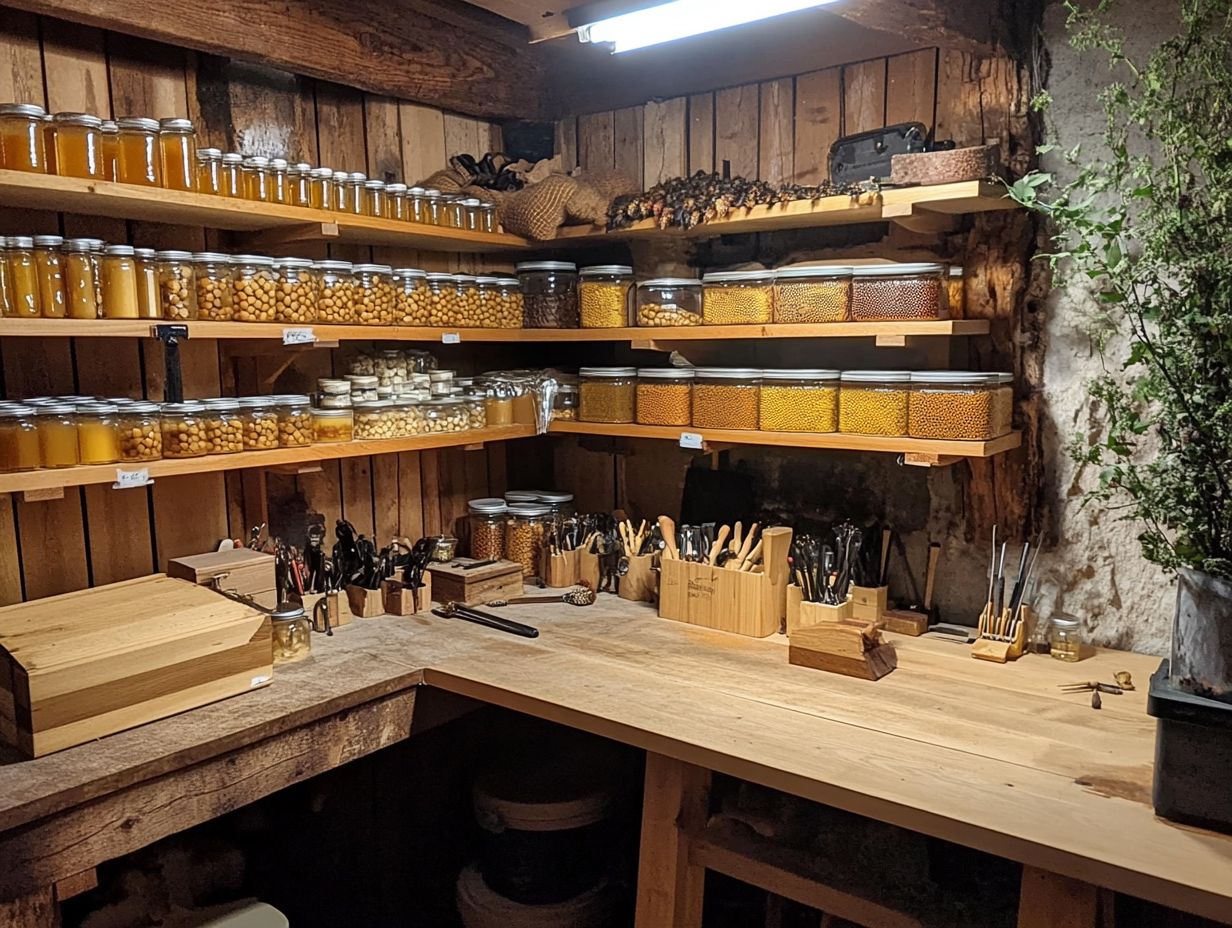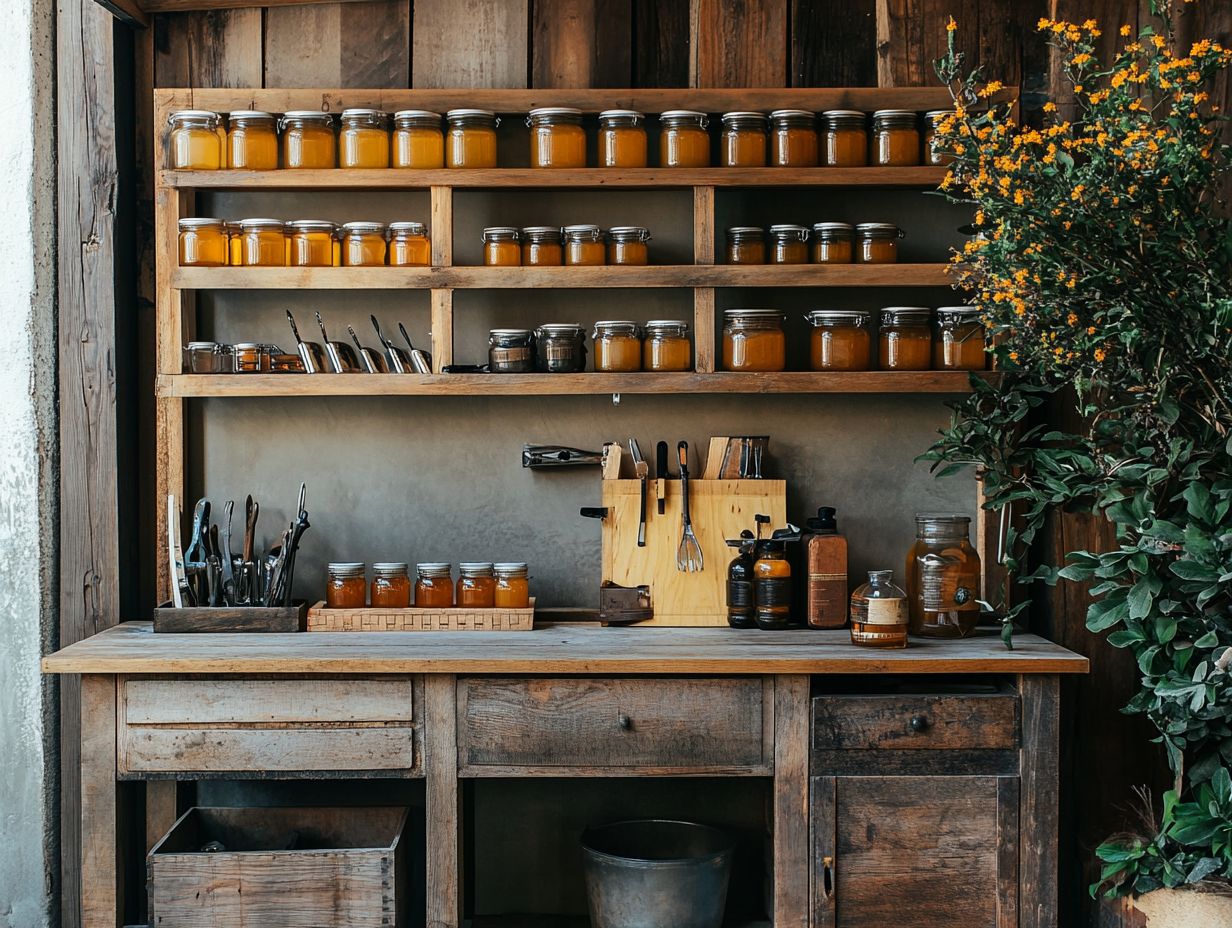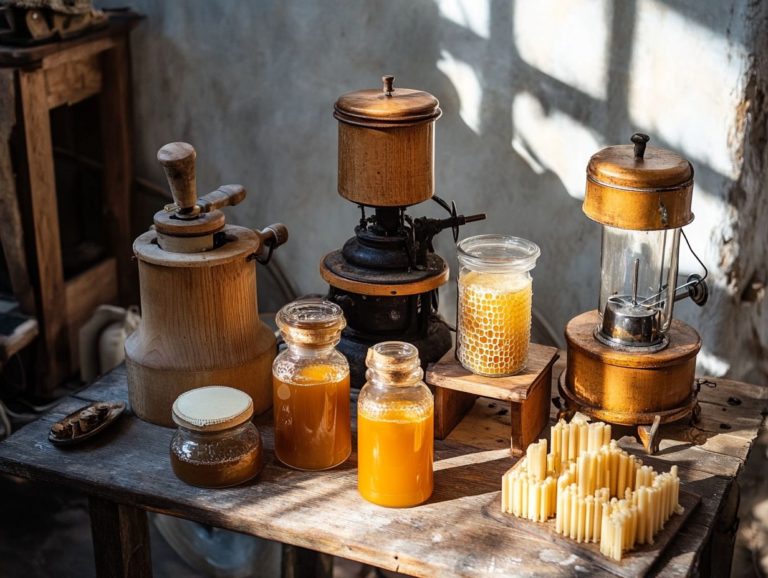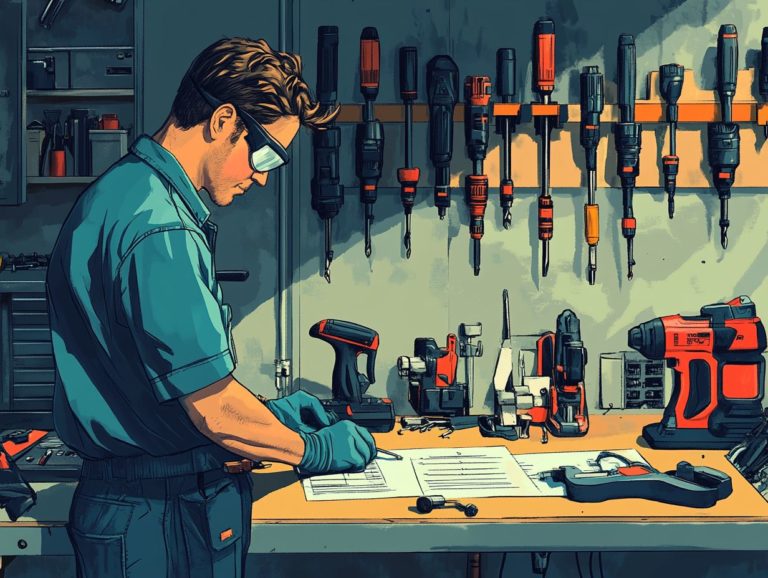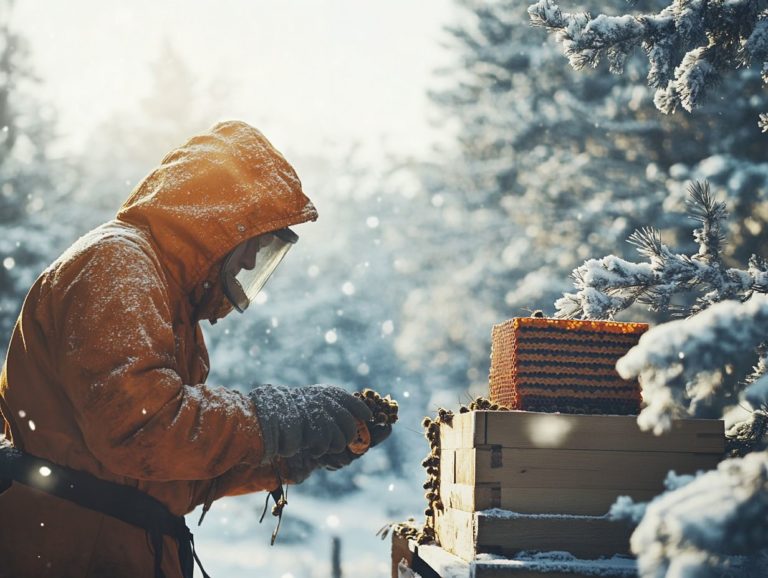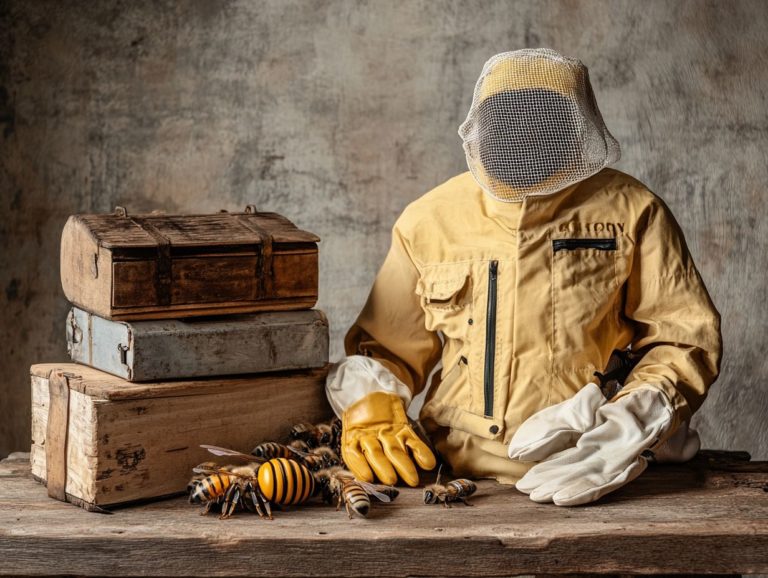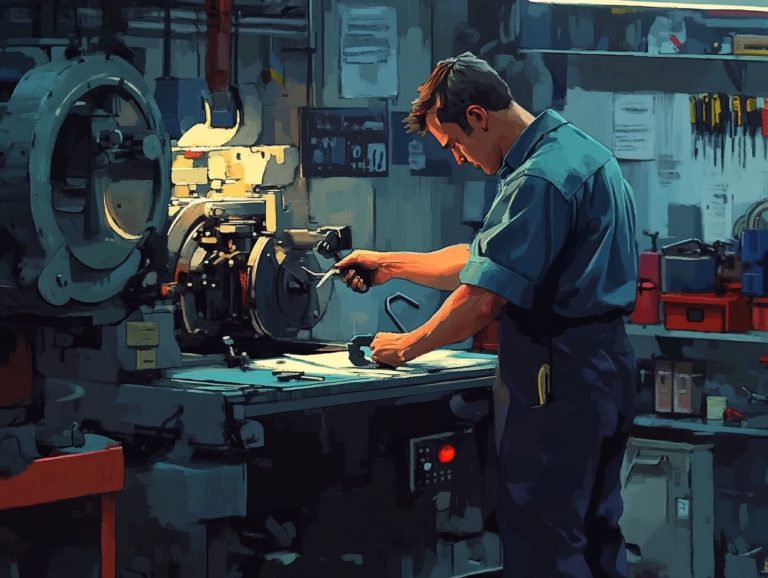Best Practices for Beekeeping Tool Storage
Proper tool storage is crucial for you as a beekeeper. It ensures that your beekeeping equipment lasts longer and that your work remains safe and efficient.
This article explores the importance of protecting your tools from damage, maintaining organization, and preventing accidents in beekeeping practices.
It highlights essential tools that every beekeeper should store, such as the hive tool, smoker, and honey extractor. It identifies the best storage locations and offers practical tips for keeping your clean equipment in top shape.
Whether you’re an experienced professional or just starting your journey into beekeeping, mastering tool storage can enhance your beekeeping experience.
Contents
- Beekeeping Best Practices
- What Tools Do Beekeepers Need to Store?
- Where Should Beekeepers Store Their Tools?
- How to Properly Store Beekeeping Tools
- 1. Clean and Dry Tools Before Storage
- 2. Use Airtight Containers
- 3. Label and Organize Tools
- 4. Store Tools in a Cool, Dry Place
- 5. Regularly Inspect and Maintain Tools
- Frequently Asked Questions
- What are the best practices for beekeeping tool storage?
- How should beekeeping tools be cleaned?
- What is the recommended way to organize beekeeping tools?
- How can beekeeping tools be protected from the elements?
- Should beekeeping tools be stored near the beehives?
- How often should beekeeping tools be inspected and replaced?
Key Takeaways:
- Store your beekeeping tools securely to prevent damage.
- Organize your tools for easy access and to prevent accidents.
- Clean, label, and maintain your tools, including protective clothing, to ensure longevity.
Why is Proper Tool Storage Important for Beekeepers?
Proper storage is vital for beekeepers. It ensures your equipment remains in peak condition and supports both the health of your honey bees and the efficiency of your operations.
By protecting essential tools like the smoker, hive tool, and honey extractor from damage, you can maintain your hives effectively and avoid unnecessary replacement costs.
Creating a designated bee shed, keeping tools clean, and organizing them logically can boost productivity and enhance safety, especially when handling bee hive frames.
1. Protects Tools from Damage
Protecting your beekeeping tools is essential. Even minor damage can lead to inefficiencies in maintaining your hives.
To promote longevity, use durable storage containers designed to shield your tools. For example, a frame holder can protect your honey extractor. Your hive tool and smoker are vital assets that require care.
Keeping them clean helps prevent rust and deterioration, ensuring they function well and your beeswax remains uncontaminated. Consider toolboxes with cushioning inserts for protection during transport.
Regularly inspecting and cleaning your tools after use not only preserves their integrity but also enhances the efficiency of your beekeeping efforts, making each visit to the hive productive.
2. Keeps Tools Organized
Organizing your beekeeping tools is essential for efficient hive management. It ensures that crucial items are always within reach.
An orderly workspace saves you time during hive inspections and creates a smoother experience for both you and the bees.
Implement practical hanging solutions for tools like the bee brush and hive tool. Consider using magnetic strips or pegboards to keep these essentials easily accessible.
Label your storage containers to create an efficient retrieval system. This allows you to focus on hive health and ensures you have your beekeeping gloves handy, rather than searching for equipment.
By adopting these organizational strategies, you can enhance productivity and maintain focus during inspections.
Beekeeping Best Practices
3. Prevents Accidents
Preventing accidents in beekeeping is essential, as improper tool storage can lead to injuries or accidents during hive maintenance. When you don’t store tools like the smoker correctly, you might unwittingly grab a hot or poorly maintained instrument, setting the stage for burns or even fires.
Disorganized storage can mean crucial protective clothing goes unnoticed, increasing your risk of stings during inspections. A misplaced hive tool could easily fall and injure your foot if the area isn’t tidy, especially if you’re not wearing proper protective clothing.
By ensuring that every piece of equipment has its own designated spot, you not only make your work more efficient but also significantly enhance the safety of everyone tending to the bees.
What Tools Do Beekeepers Need to Store?
As a beekeeper, you need a suite of essential tools stored with care to maintain efficiency and safety in your operations. This includes items like the hive tool, smoker, bee brush, and honey extractor.
Each of these tools serves a pivotal role in your beekeeping endeavors, whether you’re managing your bee hives or extracting honey from Langstroth hives, a popular type of beehive that helps keep bees organized. Implementing storage solutions that cater specifically to the unique requirements of each tool will greatly enhance their longevity and functionality, ensuring your beekeeping journey remains seamless and productive.
1. Smoker
The smoker is an essential tool in your beekeeping arsenal, designed to calm your bees during hive inspections and manipulations.
By releasing a cool, steady stream of smoke, it effectively masks the alarm signals emitted by the bees, allowing you to work with greater safety and efficiency. This soothing effect is particularly crucial during hive inspections, as it minimizes the likelihood of aggressive behavior, making the entire process much smoother.
Keep your smoker in peak condition by regularly cleaning the combustion chamber and checking that the bellows are functioning properly. Store the smoker in a cool, dry place, away from insecticides and moisture. This will help prolong its lifespan and ensure optimal performance for all your future beekeeping endeavors.
2. Hive Tool
The hive tool is an essential instrument in your beekeeping arsenal, primarily designed to pry apart hive components and scrape away excess propolis.
Its versatility doesn’t stop there; this tool also acts as a lever for lifting frames, tidying up wax debris, and assisting in various bee management tasks. To maximize its effectiveness, it’s crucial to keep your hive tool clean, as any residue can attract pests and pathogens that threaten the health of your colony.
Proper storage techniques, like hanging it in a designated spot away from moisture and direct sunlight, can help prevent rust and wear. By following these straightforward steps, you’ll extend the life of this vital instrument, ensuring it’s always ready for whatever challenge comes your way.
3. Bee Brush
The bee brush is your go-to beekeeping tool designed specifically for gently removing bees from frames during inspections. This tool not only assists you in conducting thorough checks on your colonies but also minimizes stress for the bees, ensuring their safety throughout the process.
When used correctly, the brush allows for seamless hive management, making it easier to monitor the health and productivity of your hives. Make sure to clean and store your bee brush properly after every use to ensure you’re always ready for your next hive inspection!
Regular maintenance prevents the buildup of residues that could impact its performance, while proper storage extends its lifespan, ensuring it remains a reliable tool in your beekeeping toolkit.
4. Veil and Protective Clothing
Veils and protective clothing are key for you as a beekeeper, providing safety and comfort while you work among buzzing bees.
These garments come in various styles, including full-body suits, gloves, and specially designed boots, all aimed at protecting you from stings and potential allergic reactions.
A quality veil allows you to see clearly while keeping pesky bees away from your face and neck, which is essential for staying focused during hive inspections.
To ensure your protective gear performs effectively, it’s crucial to store it in a clean, dry environment. Proper storage safeguards your materials from deterioration, prolonging their lifespan and ensuring you remain safe for any beekeeping task.
5. Honey Extractor
The honey extractor is a key tool in your beekeeping arsenal, greatly improving honey collection while preserving the integrity of delicate hive frames.
This clever device features a cylindrical tank that houses a series of rotating beehive frames. As these frames spin, centrifugal force—the force that spins honey out of the frames—dislodges the honey and guides it to the bottom for easy collection.
However, knowing how it operates is only part of the equation. Attention to maintenance is equally crucial, especially after a honey extraction. Proper storage is key; by ensuring your extractor is clean and dry, you can prevent rust and enhance the tool’s longevity and reliability, while being prepared for any beekeeping challenge ahead.
Where Should Beekeepers Store Their Tools?
Selecting the ideal storage location for your beekeeping tools is crucial for maintaining their condition and ensuring easy access. You can choose between designated indoor spaces or outdoor storage options, such as a bee shed, to keep your tools organized and shielded from environmental elements.
Each storage method offers distinct advantages, tailored to your specific needs and the types of equipment you use.
1. Indoor Storage
Indoor storage for your beekeeping tools creates a controlled environment that effectively protects your equipment from weather-related damage, particularly important for sensitive items like your honey extractor.
This setting is essential for sensitive instruments and supplies that can suffer under extreme temperatures or high humidity.
By opting for indoor storage, you can keep your tools in peak condition, effectively preventing issues like rust or mold from forming.
For example, using climate-controlled cabinets will protect delicate items such as honey extractors and protective suits from heat and moisture. Airtight bins are a great way to store supplies like wooden frames and beeswax, ensuring their longevity and optimal functionality for your future endeavors, such as maintaining hives and managing bee feed.
2. Outdoor Storage
Outdoor storage, such as a dedicated bee shed, gives you an accessible spot to keep your tools without occupying your indoor space.
This solution not only organizes your equipment but also ensures everything is within easy reach when you need it. By shielding your tools from harsh elements like rain and intense sunlight, outdoor storage can significantly prolong their lifespan, helping maintain both functionality and appearance.
These storage units can be tailored to your specific needs, complete with shelves, hooks, or bins that are perfect for keeping everything in order. With well-planned outdoor storage, you can enjoy a clutter-free environment, allowing you to focus more on your beekeeping passion rather than the chaos of disorganized tools.
Get organized today and elevate your beekeeping game!
How to Properly Store Beekeeping Tools
Storing your beekeeping tools properly requires a thoughtful approach to enhance their longevity and effectiveness. Make sure to clean your equipment thoroughly, use airtight containers, and clearly label your tools.
By following these best practices, you can keep your essential tools in prime condition, ensuring they’re always ready when you need them. Regularly inspect the smoker and other tools to spot any maintenance needs before they turn into larger issues.
1. Clean and Dry Tools Before Storage
Cleaning and drying your beekeeping tools before storage is crucial for preventing rust, mold, and contamination. Ensure your equipment is completely free from residues—such as honey, wax, or other substances—to maintain your tools in optimal condition.
For example, rinse the honey extractor thoroughly to remove any sticky remnants. A quick wipe with a disinfectant cloth works wonders for your hive tool. Don’t forget the smoker; empty and clean it of ash before storage to help extend its lifespan.
After cleaning everything, dry all your tools completely, ideally in a well-ventilated area. This helps avoid moisture buildup that could lead to deterioration.
2. Use Airtight Containers
Using airtight containers for storing your beekeeping tools is essential for protecting them from moisture and pests. This is especially important for equipment like hive tools, smokers, and protective gear, which can easily be compromised in humid conditions.
When you store these tools in airtight containers, you protect them from rust and corrosion, and shield them from potential insect infestations that could damage sensitive items. Consider options such as plastic bins with rubber seals or glass jars with tight-fitting lids for different types of beekeeping gear. Smaller tools fit perfectly in jars, while larger items, like beekeeping suits or gloves, can comfortably fit in larger bins.
By using these storage solutions, you can keep your equipment in optimal condition throughout every season, including your Langstroth hive and associated gear.
3. Label and Organize Tools
Labeling and organizing your beekeeping tools not only makes everything easy to find but also eliminates confusion during hive inspections, especially with different bee hive frames.
Adopt a systematic approach to categorization to arrange your equipment by type—like hives, smokers, and protective gear—and by function, such as tools specifically designed for honey extraction or hive maintenance. This meticulous organization enhances your efficiency, reducing the time spent searching for a specific tool during inspections. A well-organized setup creates a safer working environment, minimizing the risk of accidents that can occur when tools are carelessly stored.
Understanding the advantages of proper organization can transform your beekeeping experience into something far more productive and enjoyable.
4. Store Tools in a Cool, Dry Place
Storing your beekeeping tools in a cool, dry place is essential to prevent deterioration caused by humidity and heat.
Designate a space that maintains a stable temperature, ideally between 50°F and 70°F (10°C to 21°C), and keep it away from direct sunlight. It’s crucial to avoid areas prone to moisture; excessive humidity can lead to rust and corrosion that damages metal components and weakens wooden parts.
By implementing proper storage conditions, you protect the integrity of your tools and ensure they remain in prime working condition for years to come. Regularly check the environment and consider using protective coverings to enhance the longevity of your valuable equipment.
5. Regularly Inspect and Maintain Tools
Regularly inspecting and maintaining your beekeeping tools is essential. Keeping your tools in good condition helps them last longer and keeps your bees safe.
Pay attention to vital tools like the smoker, hive tool, and protective gear. Neglecting these inspections can lead to unexpected issues and disrupt the harmony of your apiary.
Here’s a thorough checklist for inspections:
- Check the smoker for blockages.
- Examine the hive tool for rust or wear.
- Ensure that your protective clothing is free of tears.
- Inspect the frames for damage.
Follow this checklist to keep your tools in top shape. This paves the way for a productive and enjoyable beekeeping experience.
Frequently Asked Questions
What are the best practices for beekeeping tool storage?
Keep your beekeeping tools clean, organized, and protected from the elements. This ensures your equipment is always ready for use.
How should beekeeping tools be cleaned?
Clean your tools regularly with hot soapy water and a disinfectant solution. This prevents disease from spreading between hives.
What is the recommended way to organize beekeeping tools?
Store tools in a designated area like a shed or cabinet. Give each tool its own spot for easy access.
How can beekeeping tools be protected from the elements?
Store your tools in a dry, cool place to avoid rust and damage. Use protective covers or cases to shield them.
Should beekeeping tools be stored near the beehives?
No, store tools away from beehives to prevent disturbing the bees. A separate storage area is recommended.
How often should beekeeping tools be inspected and replaced?
Inspect your tools regularly for wear and tear. Replace them when necessary to ensure safe and efficient use.

